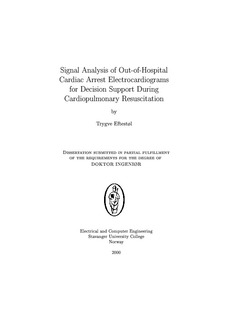| dc.contributor.author | Eftestøl, Trygve C. | nb_NO |
| dc.date.accessioned | 2014-12-19T13:29:40Z | |
| dc.date.available | 2014-12-19T13:29:40Z | |
| dc.date.created | 2000-09-22 | nb_NO |
| dc.date.issued | 2000 | nb_NO |
| dc.identifier | 125237 | nb_NO |
| dc.identifier.isbn | 82-7984-091-5 | nb_NO |
| dc.identifier.uri | http://hdl.handle.net/11250/249786 | |
| dc.description.abstract | This thesis focuses on signal analysis of electrocardiograms (ECG) from out-of-hospital cardiac arrested patients. The application of such methods may eventually contribute in guiding therapy towards improved survival rates which in general are dismally low, but varies among different ambulance systems depending on time from arrest to first electrical defibrillation given to the patient.
One of the possible reasons for this is that a large part of the valuable therapy time is wasted in futile attempts to restart the heart by electrical defibrillations. Using this time to provide precordial compressions and ventilations to establish and keep up an artificial supply of oxygenated blood would serve the patient better. It would improve the heart condition and thus increase the chance of successful defibrillation outcome.
By predicting defibrillation outcome, the ratio of failured defibrillations can be decreased. The ability to monitor therapeutic efficacy can help the rescuer to optimise performance. A decision support system involving ECG signal analysis to extract descriptive features has been investigated for these purposes in earlier work. We propose to use a pattern recognition framework for the decision support system. In contrast to most earlier work with one-dimensional features, this allows analysis of multivariate information. In our experiments we demonstrate that performance both in outcome prediction and monitoring is better when the analysis is based on combined rather than one-dimensional features. We also propose and experimentally verify methods firstly to control performance and secondly to ensure that performance results are reliable.
Another problem also has to be resolved. The precordial compressions and ventilations cause artefacts in the ECG so that treatment has to be stopped during analysis. We propose using adaptive filters for removing such artefacts. These filters use reference signals providing information correlated to components in the artefacts. In one of our experiments we mix human ECG with artefacts from animal ECG and show that the adaptive filter is successful in restoring the original human ECG signal. | nb_NO |
| dc.language | eng | nb_NO |
| dc.publisher | Fakultet for informasjonsteknologi, matematikk og elektroteknikk | nb_NO |
| dc.relation.ispartofseries | Dr. ingeniøravhandling, 0809-103X; 2000:66 | nb_NO |
| dc.subject | Signalbehandling | en_GB |
| dc.subject | TECHNOLOGY: Information technology: Signal processing | en_GB |
| dc.title | Signal analysis of out-of-hospital cardiac arrest electrocardiograms for decision support during cardiopulmonary resuscitation | nb_NO |
| dc.type | Doctoral thesis | nb_NO |
| dc.source.pagenumber | 160 | nb_NO |
| dc.contributor.department | Norges teknisk-naturvitenskapelige universitet, Fakultet for informasjonsteknologi, matematikk og elektroteknikk | nb_NO |
| dc.description.degree | dr.ing. | nb_NO |
| dc.description.degree | dr.ing. | en_GB |
